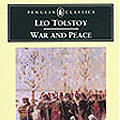Finding Inspiration in Tolstoy's War and Peace

War and Peace is a daring, epic novel that tells the story of the Napoleonic invasion of Russia in 1812. It paints a vivid tableau of Russian society at the beginning of the nineteenth-century. Written and published before Anna Karenina, from 1865 to 1869 (when Tolstoy was in his late 30s), War and Peace tells of four aristocratic families—the Bezukhovs, Bolkonskies, Rostovs and Kuragins—whose personal lives become caught up in the tumultuous events of the time.
In War and Peace, Tolstoy maintains a delicate balance between stirring scenes of major historical events and intimate portraits of daily life. In 365 chapters (approximately 1500 pages), the author moves back and forth between social life and military life, ballrooms and battles, marriages and massacres, and many venues in between. No character is too small and no subject too large for Tolstoy's broad literary canvas. One critic from Tolstoy's time called its author "a reflector as vast as a natural lake; a monster harnessed to his great subject—all of human life!"
Characters that live and breathe
In War and Peace, Tolstoy maintains a delicate balance between stirring scenes of major historical events and intimate portraits of daily life. In 365 chapters (approximately 1500 pages), the author moves back and forth between social life and military life, ballrooms and battles, marriages and massacres, and many venues in between. No character is too small and no subject too large for Tolstoy's broad literary canvas. One critic from Tolstoy's time called its author "a reflector as vast as a natural lake; a monster harnessed to his great subject—all of human life!"
Characters that live and breathe
Tolstoy depicts a vast array of characters from all walks of life. Each character is remarkably real and irreducibly individual. In fact, Tolstoy's realism has had such a lasting impact that even today an ordinary Russian can usually recall in colorful detail how her favorite character in War and Peace speaks, dresses and behaves, as if they were someone from her own life.
Pierre Bezukhov: War and Peace has several heroes. One of the most famous is this illegitimate son of a wealthy Russian count. At the beginning of the novel, Pierre unexpectedly inherits a large fortune and is thrust into a world of conflict and responsibility. Like Levin in Anna Karenina, Pierre is naïve and socially awkward, and he is on a passionate quest for meaning. He is seduced by and marries the beautiful, immoral Helene Kuragin—a union which ends bitterly. Pierre then tries Freemasonry but becomes disillusioned. He attempts social reform on his estate with disastrous financial results. He even believes at one point that he is destined to end Napoleon's rule. The fraught hero ultimately finds happiness in the family he creates with Natasha Rostova.
Natasha Rostova: One of Tolstoy's best known female characters, Natasha is similar to Kitty in Anna Karenina. Natasha represents the purity of the Russian soul. At the beginning of the novel she lights up other peoples' lives with her childlike spontaneity and her creative energy, and she eventually matures into a calm, responsible adult. Some readers are disappointed that Tolstoy has Natasha lose her delightfully impulsive nature by the novel's end, but Tolstoy believed that this process had to happen in order for Natasha to embrace her noblest calling of all: to become a loving wife and mother.
Prince Andrew Bolkonsky: He is another of the novel's prominent characters and is Pierre's closest friend. Prince Andrew's cold, mysterious nature is in stark contrast with Pierre's warm, free-flowing spirit. At one point Andrew is engaged to Natasha, but uncontrollable events intervene. The fact that Prince Andrew's closest friend will eventually marry Natasha demonstrates Tolstoy's belief in the strong interconnectedness of human destinies.
The big picture
Tolstoy's sprawling novel still arouses in readers a sense of mystery and awe in the infinite possibilities of human life. Depicted are the joys, sorrows, struggles and sensual delights of the world. Many of the novel's greatest moments, such as Natasha Rostova's first grand ball, the Rostov's wolf hunt and Prince Andrew's vision of the "lofty infinite sky" on the battlefield at Austerlitz, are among the most moving and memorable scenes in all of world literature.
Of the important messages in War and Peace, one is that every human being is sacred and has great influence over his or her personal destiny. While none of us can control the large, impersonal forces of history, war and death, each of us can make positive choices in our everyday lives—choices that help create happiness for ourselves and the important people in our lives.



